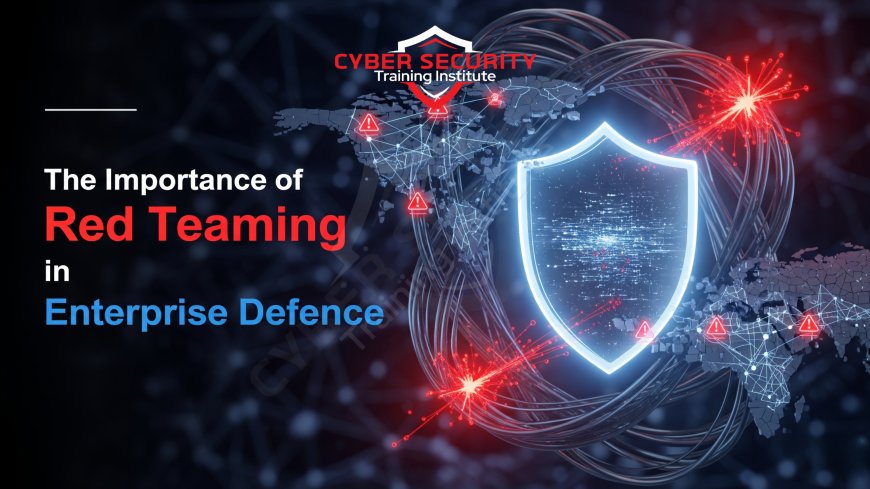The Importance of Red Teaming in Enterprise Defense
In the world of enterprise defense, red teaming is the ultimate stress test for your security program. This in-depth article explains the critical importance of moving beyond standard security scans and penetration tests to a true, goal-oriented adversary simulation. We break down what a red team exercise is, how it differs from other forms of testing, and the typical playbook a red team follows to mimic a real-world, sophisticated attacker. Discover why the most significant value of red teaming lies not just in finding technical flaws, but in testing the real-world effectiveness of your people and processes—the blue team. The piece features a detailed comparative analysis that clearly distinguishes the goals, scope, and outcomes of vulnerability assessments, penetration tests, and red team engagements. We also explore the modern, collaborative evolution of this practice known as "purple teaming." This is an essential read for any security leader or CISO who wants to understand how to move their security program from a state of "Are we vulnerable?" to the much more important question of "Are we ready?" and how to use adversarial simulation to find the true gaps in their defenses.

Introduction: The Ultimate Security Stress Test
You have the best security tools money can buy. You have a state-of-the-art Security Operations Center (SOC) and a team of skilled defenders watching the screens 24/7. Your digital fortress seems impenetrable. But have you ever actually tested it against a real, thinking, and determined adversary? This is the critical role of red teaming. It's not just about looking for a list of potential vulnerabilities; it's about simulating a real-world, goal-oriented attack to put your entire security program—your technology, your processes, and your people—to the ultimate test. Red teaming is critically important for modern enterprise defense because it moves beyond theoretical security checks to provide a realistic, adversarial assessment of an organization's true security posture, identifying not just the technical flaws but the often-hidden weaknesses in detection, response, and human processes.
More Than a Pentest: What is Red Teaming?
It's important to understand that red teaming is not just another name for a penetration test. They are related but have fundamentally different goals.
- Vulnerability Scanning: This is an automated scan that looks for known weaknesses. It's wide but shallow, often producing a long list of potential problems.
- Penetration Testing (Pentesting): This is where a human ethical hacker tries to find and exploit as many vulnerabilities as they can within a defined scope and time period. The goal is to produce a list of exploitable flaws.
- Red Teaming: This is a goal-oriented adversary simulation. The "red team" (the attackers) is given a specific, high-value objective, just like a real criminal group would have (e.g., "Steal the 'Project X' source code" or "Gain control of the financial reporting system"). They will then use any means necessary to achieve that one specific goal over a period of weeks, while trying their absolute best to remain undetected. The primary goal of a red team is not to find a list of bugs, but to test the "blue team's" (the defenders') ability to detect and respond to a realistic, stealthy attack.
The Red Team Playbook: Simulating a Real-World Adversary
A red team engagement is designed to mimic the lifecycle of a real, sophisticated attack as closely as possible. The process is methodical and stealthy.
- The Objective: The engagement starts with a clear, high-value objective that is agreed upon with the organization's leadership. This acts as the "crown jewel" that the red team will try to capture.
- Reconnaissance: The red team starts from the outside with zero knowledge, just like a real attacker. They will gather open-source intelligence (OSINT) to learn about the company's technology, its employees, and potential weaknesses.
- The Initial Compromise: They will then use a variety of techniques to gain an initial foothold in the network. This will almost always be a stealthy method, like a highly targeted spear-phishing email to a specific employee.
- The "Low-and-Slow" Intrusion: Once inside, their primary goal is to remain undetected. They will use "living off the land" techniques, abusing legitimate system tools to slowly and quietly move laterally through the network, escalate their privileges, and make their way towards their objective. They will actively try to evade the company's security tools and the watchful eyes of the SOC.
The engagement is considered a "success" for the red team if they are able to achieve their objective without being detected and stopped by the blue team. .
The Real Value: Testing Your People and Processes
The single most important impact of a red team exercise is that it tests your entire security program, not just your technology. A vulnerability scan tells you if you have a broken lock. A red team exercise tells you if your security guards are paying attention and if your emergency response plan actually works.
The primary goal is to provide a real-world training exercise and an evaluation for the defensive "blue team." The final report will answer critical questions that a simple pentest cannot:
- Did our expensive security tools (like our EDR and SIEM) actually generate the right alerts for this type of stealthy activity?
- If they did generate alerts, did our human SOC analysts see them and correctly identify them as part of a larger, coordinated attack?
- Once the attack was identified, did the team follow the official incident response plan correctly and efficiently?
- How long did it take, from the initial compromise to the final containment, for the blue team to find and stop the "attacker"? This is the critical "dwell time" metric.
More often than not, a red team exercise will reveal critical gaps not in the company's technology, but in its human processes. Maybe the tools fired the right alert, but it was lost in a sea of false positives. Maybe the incident response plan was outdated or the right person wasn't on call. These are the invaluable insights that allow a security program to truly mature.
Comparative Analysis: Vulnerability Assessment vs. Pentesting vs. Red Teaming
While all are forms of security testing, these three disciplines have very different goals, scopes, and outcomes.
| Aspect | Vulnerability Assessment | Penetration Testing | Red Teaming |
|---|---|---|---|
| Primary Goal | To identify and produce a list of potential vulnerabilities across a wide range of systems. The focus is on breadth. | To actively exploit known vulnerabilities to determine the level of risk and how far an attacker could get. The focus is on depth. | To simulate a real-world adversary with a specific objective in order to test the blue team's detection and response capabilities. |
| Scope | Is typically very broad. The goal is to "find all the potential problems" across the entire network. | Is often narrow and focused on a specific application or network segment within a limited time frame. | Is broad and objective-oriented. The scope is defined by whatever the red team needs to do to achieve their specific goal. |
| Methodology | Is almost always automated, using commercial or open-source vulnerability scanners. | Is a mix of automated scanning and manual, human-driven exploitation of the vulnerabilities that are found. | Is primarily manual, human-driven, and focused on stealth and the emulation of a specific adversary's TTPs. |
| Guiding Question | "What are our weaknesses?" | "Can our weaknesses be exploited?" | "Can we detect and respond to a real, determined attacker before they achieve their goal?" |
| Primary Beneficiary | The IT and patch management teams, who are given a list of things to fix. | The application owners and the infrastructure teams, who need to understand the risk of specific flaws. | The Security Operations Center (SOC) and the CISO, whose people, processes, and tools are being tested. |
The "Purple Team": Maximizing the Value of the Exercise
The modern and most effective evolution of red teaming is a collaborative approach known as "purple teaming." In the traditional, purely adversarial model, the red team and the blue team are kept completely separate, and the engagement is often a complete surprise to the blue team. While this can be a good test, it can also lead to a simple "pass/fail" outcome without maximizing the learning opportunities.
A purple team exercise is a more collaborative process where the red and blue teams work together. During the exercise, the two teams are in constant communication. The red team will announce their actions:
"I am now attempting to steal credentials from this server's memory using a tool that mimics a known adversary's TTP. Can you see this on your EDR console?"
The blue team can then immediately check their tools. If they can't see the attack, the two teams can work together, right then and there, to figure out why the tool missed it and to write a new, effective detection rule. This collaborative approach provides an incredibly valuable, real-time training experience for the blue team and allows them to immediately and measurably improve their defenses during the exercise itself.
Conclusion: From "Are We Vulnerable?" to "Are We Ready?"
Red teaming is the ultimate test of a security program's real-world effectiveness. It moves beyond the simple, technical question of "Are we vulnerable?" to answer the far more important and strategic question: "Are we ready?" It is the only way to truly understand how your layers of expensive security technology, your carefully written response plans, and your highly trained team of human analysts will actually perform in the face of a stealthy, determined, and intelligent adversary.
It provides an unparalleled, data-driven assessment of your people, processes, and technology, revealing the gaps that a real attacker would inevitably exploit. You can have the strongest walls and the most advanced alarms, but you will never know how secure your fortress truly is until you pay a team of experts to try and break in. That is the essential and irreplaceable importance of red teaming in modern enterprise defense.
Frequently Asked Questions
What is a red team?
A red team is a group of ethical hackers who emulate the tactics, techniques, and procedures (TTPs) of real-world adversaries to test an organization's defensive capabilities.
What is a blue team?
A blue team is the internal security team that is responsible for defending an organization's network. The Security Operations Center (SOC) is typically the core of the blue team.
What is a purple team?
A purple team is not a separate team, but a collaborative exercise where the red team (attackers) and the blue team (defenders) work together to improve security. The goal is training and immediate improvement, not just testing.
How is a red team exercise different from a penetration test?
A penetration test is focused on finding and exploiting as many vulnerabilities as possible. A red team exercise is a goal-oriented adversary simulation that is designed to test the blue team's ability to detect and respond to a stealthy attack.
What are TTPs?
TTPs stand for Tactics, Techniques, and Procedures. It is a framework used to describe the real-world behaviors of cyber attackers. A red team will emulate a specific adversary's TTPs.
What is a SOC?
A SOC, or Security Operations Center, is the centralized team of people, processes, and technology that is responsible for monitoring and defending an organization from cyberattacks. They are the blue team.
What is the main goal of a red team exercise?
The main goal is to test and improve the blue team's detection and response capabilities. The goal is not just to "break in," but to see if the defenders can catch the red team in the act.
Is red teaming expensive?
Yes, a full-scope red team engagement is typically a very expensive and time-consuming exercise, as it involves a team of highly skilled, senior security professionals. This is why it is usually only performed by mature organizations.
How often should a company do a red team exercise?
For a mature organization, it is a good practice to perform a red team exercise annually or biennially to test the full security program.
What is "living off the land"?
This is a technique where an attacker uses legitimate, pre-installed system tools (like PowerShell) to carry out their attack. Red teams use this technique extensively to remain stealthy.
What is OSINT?
OSINT, or Open-Source Intelligence, is intelligence that is gathered from publicly available sources. It is the first step in a red team exercise, where the team tries to find information about the target company online.
What is a CISO?
CISO stands for Chief Information Security Officer. This is the executive who is typically the primary stakeholder and sponsor of a red team engagement.
What is "dwell time"?
Dwell time is the length of time that an attacker has undetected access inside a network. A key goal of a blue team is to reduce this time, and a red team exercise is a great way to measure it.
What is an EDR tool?
EDR stands for Endpoint Detection and Response. It is a key security tool that the blue team uses to monitor for the suspicious activity that a red team will generate on the endpoints.
What is a "crown jewel" asset?
This is a term for an organization's most valuable and sensitive data or systems. The objective of a red team exercise is often to see if the red team can gain access to a specific crown jewel.
Who performs red team exercises?
They are performed by highly specialized security consultants. Some very large organizations also have their own internal, dedicated red team.
What is the difference between a vulnerability and an exploit?
A vulnerability is a weakness in a system. An exploit is a piece of code or a technique that takes advantage of that weakness to cause an unintended behavior.
Is a red team just focused on technical hacking?
No. A full-scope red team can also test physical security (e.g., trying to tailgate into the building) and human security (e.g., using social engineering and phishing).
What happens after a red team exercise?
The red team provides a detailed report to the organization's leadership. This report outlines the attack path they took, what the blue team did and did not detect, and provides a prioritized list of recommendations for improving people, processes, and technology.
What is the biggest benefit of red teaming?
The biggest benefit is that it provides a real-world, data-driven answer to the question, "How secure are we really?" It moves an organization's understanding of its security from a theoretical checklist to a practical, proven reality.
What's Your Reaction?
 Like
0
Like
0
 Dislike
0
Dislike
0
 Love
0
Love
0
 Funny
0
Funny
0
 Angry
0
Angry
0
 Sad
0
Sad
0
 Wow
0
Wow
0








![How to Install RHEL 10 on VMware/VirtualBox [Tutorial]](https://www.cybersecurityinstitute.in/blog/uploads/images/202509/image_430x256_68b56dc967a4a.jpg)







